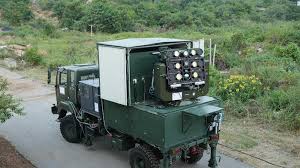Syllabus:
GS3: Achievements of Indians in science & technology.
Context:
India successfully tested its first high-energy laser weapon, the Mk-II(A) Laser-Directed Energy Weapon (DEW), at the National Open Air Range in Kurnool, Andhra Pradesh.
More on the news:
- India has become 4th country along with the US, China, and Russia, that have shown such a capability.
- The successful trials of a high-powered Directed Energy Weapon (DEW) System demonstrated Indian capability to target drones, missiles and combat aircraft using advanced laser technology.
- The Defence Research and Development Organisation’s Mk-II(A) Laser- Directed Energy Weapon generates a 30KW laser that can burn through enemy drones and can easily be used to blind surveillance equipment as well.
- The weapon can engage targets at the speed of light, using a laser beam to cause structural failure or destroy warheads, offering a cost-effective alternative to traditional ammunition with minimal collateral damage.
- DRDO plans to induct the land-based system within two years, with future upgrades for greater range and applications on ships, aircraft, and satellites.
Directed Energy Weapons (DEWs)
- They harness concentrated energy to neutralize threats with unprecedented precision and speed.
- Unlike conventional munitions, which rely on physical projectiles or explosives, DEWs deliver energy through lasers, microwaves, or particle beams to disable or destroy targets.
Types:
Laser-based DEWs, emit highly focused beams of light that travel at the speed of light (approximately 300,000 kilometers per second).
- When this beam strikes a target, it transfers intense heat, causing structural failure, melting critical components, or detonating warheads.
- For instance, India’s 30-kilowatt Mk-II(A) laser demonstrated its ability to neutralize drones and sensors up to 5 km away by inducing catastrophic overheating in seconds.
Microwave-based DEWs, another category, emit electromagnetic pulses to disrupt or destroy electronic systems.
- These are particularly effective against swarms of drones or missile guidance systems, as they can disable multiple targets simultaneously within a wide area.
Particle beam weapons accelerate charged particles to damage targets at the molecular level, offering potential for future applications.
Advantages of DEWs:
- They require no physical ammunition.
- Reduced logistical burdens and costs.
- Engagements are estimated to cost very less per shot compared to thousands for missiles.
- Their speed-of-light delivery ensures near-instantaneous impact, critical for countering fast-moving threats like hypersonic missiles.
- They produce minimal collateral damage, making them ideal for precision strikes in populated areas.
Mains Practise Question
Q. Directed Energy Weapons (DEWs) represent a paradigm shift in modern warfare.” Discuss India’s advancements in this field and their strategic implications.
Mains PYQ:
Q. How is S-400 air defence system technically superior to any other system presently available in the world? (2021)

